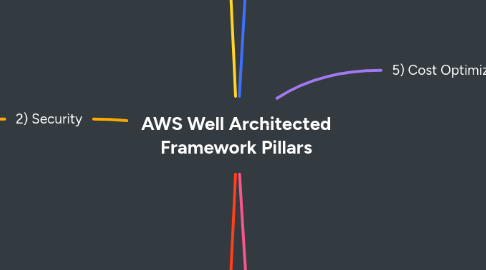
1. 1) Operational Excellence
1.1. Definition
1.1.1. Ability to run and monitor systems to deliver business value and continually improve supporting process and procedures
1.2. Design Principles
1.2.1. Perform operations as code
1.2.2. Annotate documentation
1.2.3. Make frequent, small, reversible changes
1.2.4. Refine operations procedures frequently
1.2.5. Anticipate failure
1.2.6. Learn from all operational failures
1.3. Services
1.3.1. Prepare
1.3.1.1. AWS CloudFormation
1.3.1.2. AWS Config
1.3.2. Operate
1.3.2.1. AWS CloudFormation
1.3.2.2. AWS Config
1.3.2.3. AWS CloudTrail
1.3.2.4. Amazon CloudWatch
1.3.2.5. AWS X-Ray
1.3.3. Evolve
1.3.3.1. AWS CloudFormation
1.3.3.2. AWS CodeBuild
1.3.3.3. AWS CodeCommit
1.3.3.4. AWS CodeDeploy
1.3.3.5. AWS CodePipeline
2. 2) Security
2.1. Definition
2.1.1. Ability to protect information, systems, and assets while delivering business value through risk assessments and mitigation strategies
2.2. Design Principles
2.2.1. Implement a strong identity foundation
2.2.2. Enable traceability
2.2.3. Apply security at all layers
2.2.4. Automate security best practices
2.2.5. Protect data in transit and at rest
2.2.6. Keep people away from data
2.2.7. Prepare for security events
2.2.8. Shared Responsibility Model
2.3. Services
2.3.1. Identity and Access Management
2.3.1.1. IAM
2.3.1.2. AWS STS
2.3.1.3. MFA Token
2.3.1.4. AWS Organizations
2.3.2. Detective Controls
2.3.2.1. AWS Config
2.3.2.2. AWS CloudTrail
2.3.2.3. Amazon CloudWatch
2.3.3. Infrastructure Protection
2.3.3.1. Amazon CloudFront
2.3.3.2. Amazon VPC
2.3.3.3. AWS Shield
2.3.3.4. AWS WAF
2.3.3.5. Amazon Inspector
2.3.4. Data Protection
2.3.4.1. KMS
2.3.4.2. S3
2.3.4.3. Elastic Load Balancer
2.3.4.4. Amazon EBS
2.3.4.5. Amazon RDS
2.3.5. Incidence Response
2.3.5.1. IAM
2.3.5.2. AWS CloudFormation
2.3.5.3. Amazon CloudWatch Events
3. 3) Reliability
3.1. Definition
3.1.1. Ability of a system to recover from infrastructure or serve disruptions, dynamically acquire computing resources to meet demand, and mitigate disruptions such as misconfigurations or transient network issues
3.2. Design Principles
3.2.1. Test recover procedures
3.2.2. Automatically recover from failure
3.2.3. Scale horizontally to increase aggregate system availability
3.2.4. Stop guessing capacity
3.2.5. Manage change in automation
3.3. Services
3.3.1. Foudations
3.3.1.1. IAM
3.3.1.2. VPC
3.3.1.3. Service Quotas
3.3.1.4. AWS Trusted Advisor
3.3.2. Change Management
3.3.2.1. AWS Auto Scaling
3.3.2.2. Amazon CloudWatch
3.3.2.3. AWS CloudTrail
3.3.2.4. AWS Config
3.3.3. Failure Management
3.3.3.1. Backups
3.3.3.2. AWS CloudFormation
3.3.3.3. Amazon S3
3.3.3.4. Amazon S3 Glacier
3.3.3.5. Amazon Route 53
4. 4) Performance Efficiency
4.1. Definition
4.1.1. Ability to use computing resources efficently to meet system requirements, and to mantain that efficiency as demand changes and technologies evolve
4.2. Design Principles
4.2.1. Democratize advanced technologies
4.2.2. Go global in minutes
4.2.3. User serverless architecture
4.2.4. Experiment more often
4.2.5. Mechanical sympathy
4.3. Services
4.3.1. Selection
4.3.1.1. AWS Auto Scaling
4.3.1.2. AWS Lambda
4.3.1.3. Amazon Elastic Block Store
4.3.1.4. Amazon S3
4.3.1.5. Amazon RDS
4.3.2. Review
4.3.2.1. AWS CloudFormation
4.3.2.2. AWS News Blog
4.3.3. Monitoring
4.3.3.1. Amazon CloudWatch
4.3.3.2. AWS Lambda
4.3.4. Tradeoffs
4.3.4.1. Amazon RDS
4.3.4.2. Amazon ElastiCache
4.3.4.3. AWS Snowball
4.3.4.4. Amazon CloudFront
5. 5) Cost Optimization
5.1. Definition
5.1.1. Ability to run systems to deliver business value at the lowest price point
5.2. Design Principles
5.2.1. Adopt a consumption mode
5.2.2. Measure overall efficiency
5.2.3. Stop spending money on data center operations
5.2.4. Analyze and attribute expenditure
5.2.5. Use managed and application level services to reduce cost of ownership
5.3. Services
5.3.1. Expenditure Awareness
5.3.1.1. AWS Budgets
5.3.1.2. AWS Cost and Usage Report
5.3.1.3. AWS Cost Explorer
5.3.1.4. Reserved Instance Reporting
5.3.2. Cost-Effective Resources
5.3.2.1. Spot Instances
5.3.2.2. Reserved instances
5.3.2.3. Amazon S3 Glacier
5.3.3. Matching supply and demand
5.3.3.1. AWS Auto Scaling
5.3.3.2. AWS Lambda
5.3.4. Optimizing Over Time
5.3.4.1. AWS Trusted Advisor
5.3.4.2. AWS Cost and Usage Report
5.3.4.3. AWS News Blog
6. 6) Sustainability
6.1. Definition
6.1.1. Focus on minimizing the environmental impacts of running cloud workloads
6.2. Design Principles
6.2.1. Understand your impact
6.2.2. Establish sustainability goals
6.2.3. Maximize utilization
6.2.4. Anticipate and adopt new, more efficient hardware and software offerings
6.2.5. Use managed services
6.2.6. Reduce the downstream impact of your cloud wordload
6.3. Services
6.3.1. EC2 AutoScaling
6.3.2. Serverless offering
6.3.3. Cost Explorer
6.3.4. AWS Graviton 2
6.3.5. EC2 T instances
6.3.6. EC2 Spot instances
6.3.7. EFS-IA
6.3.8. Amazon S3 Glacier
6.3.9. S3 Lifecycle configurations
6.3.10. S3 Intelligent tiering
6.3.11. Amazon Data Lifecycle Manager
6.3.12. RDS Read Replicas
6.3.13. Aurota Global DB
6.3.14. DynamoDB Global Table
6.3.15. CloudFront
